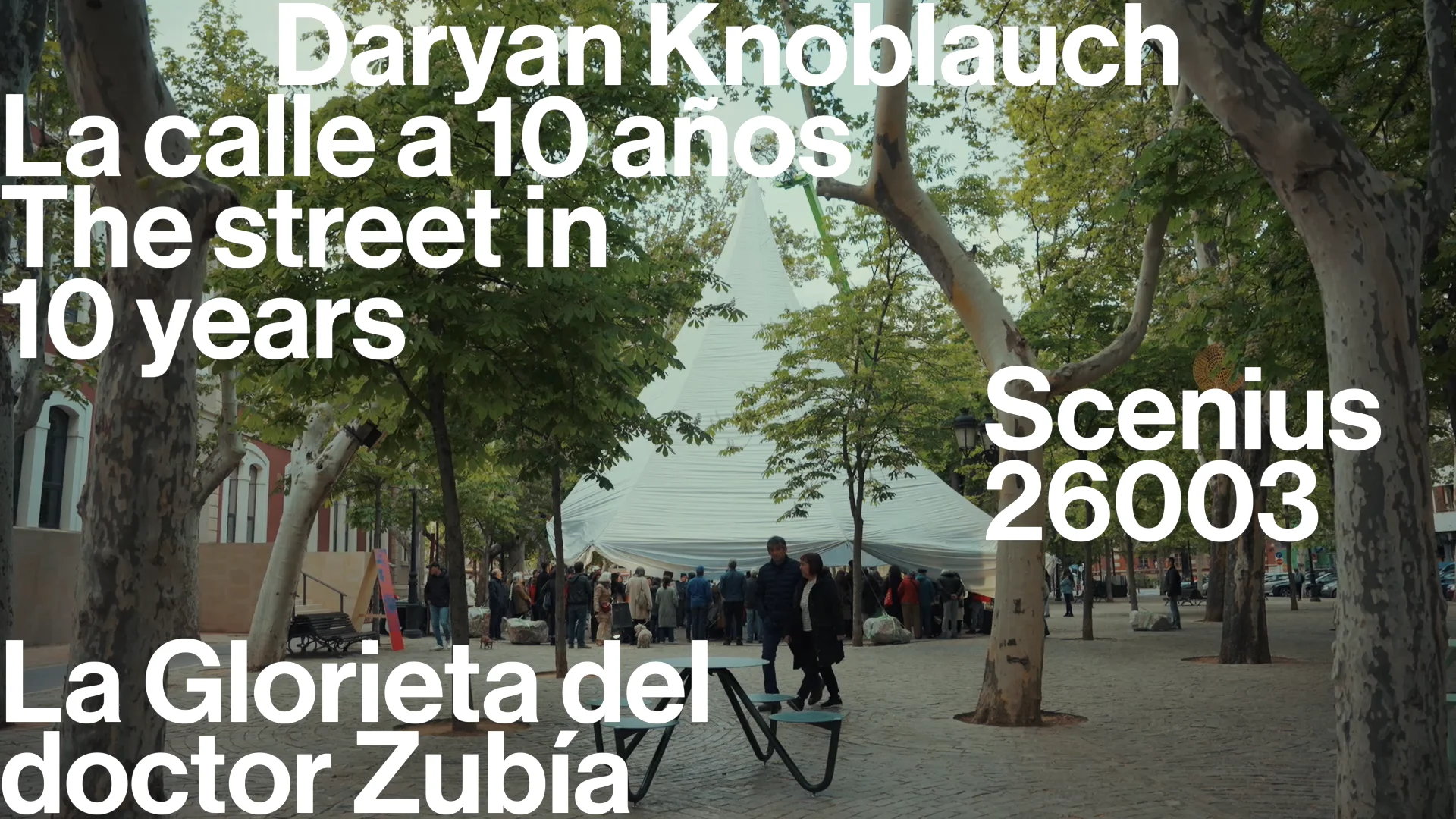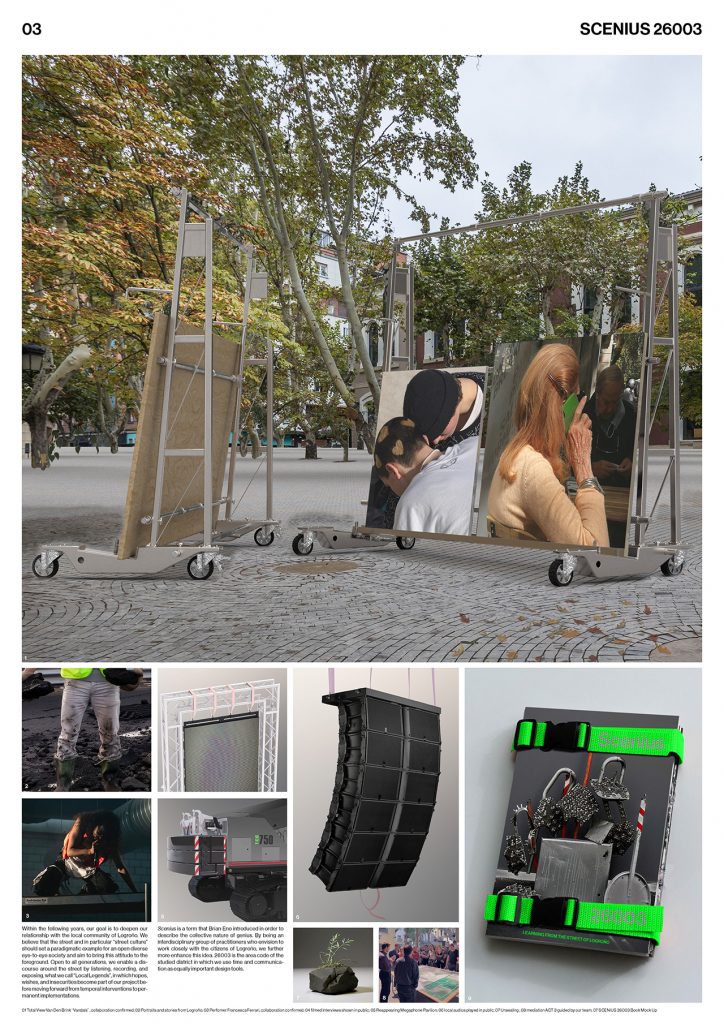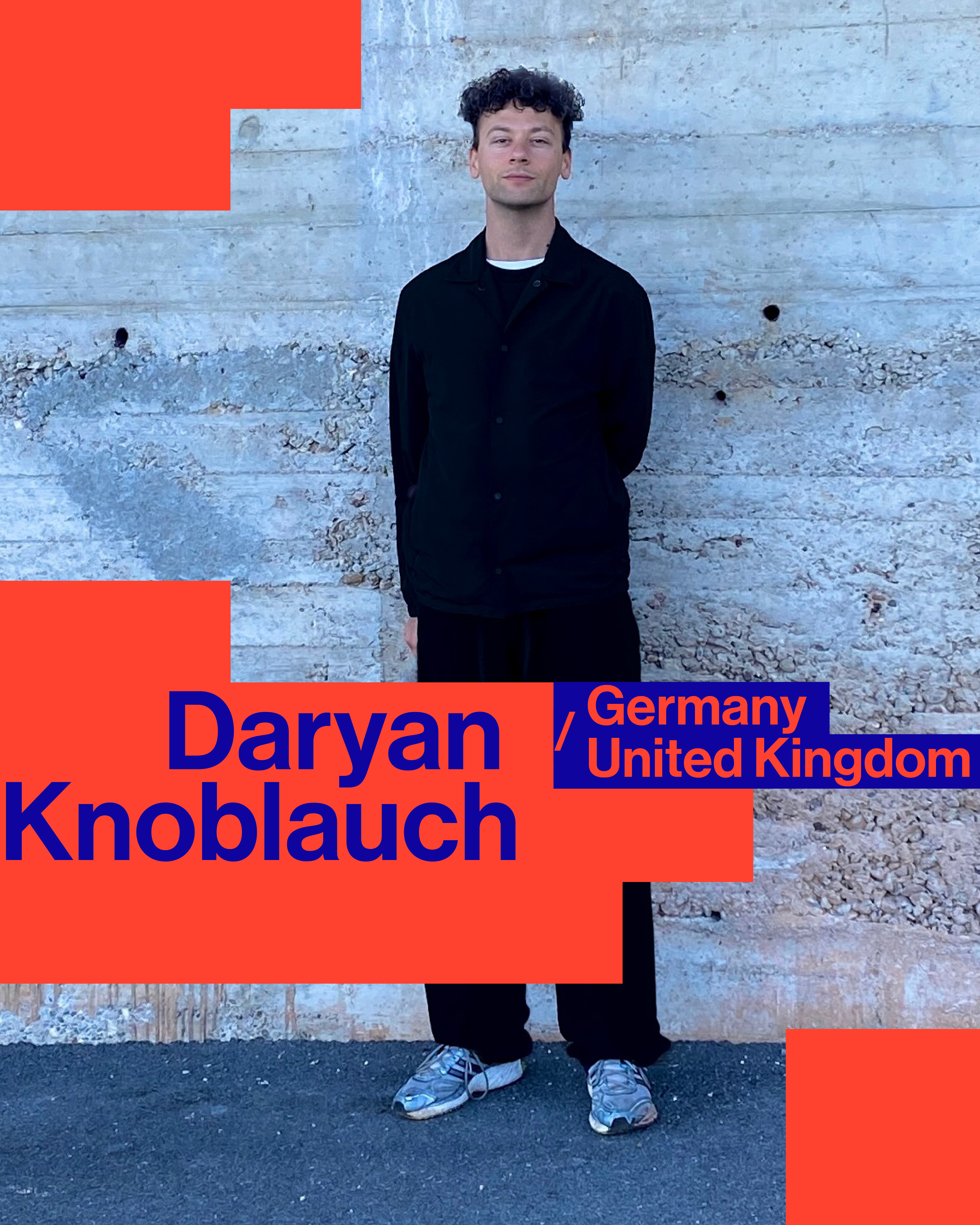Scenius 26003
Learning from the Streets of Logroño
Daryan Knoblauch
The Street in 10 Years – Concéntrico 10
Project Statement
Scenius 26003 is a critic towards conventional city planning. It uses the 10-year time frame to learn from the street of Logroño in order to strengthen and nurture what already can be found onsite. By studying, evaluating, and analysing the street through conversations with locals, experts, and cultural producers, Scenius 26003 proposes an open process that is both iterative and incomplete by design. The proposal stands in opposition to the omnipresent primarkisation of current city planning offering the same solution: e-everything + greenwashing + street food = good future. It stands in favor of giving a voice to a young team channeling contemporary movements into experiments that nurture an open-source platform striving for deep-rooted mechanisms of care, change, and diversity.
Concéntrico 10
In 2024 we propose, among other temporal interventions, a tent architecture called The Megaphone. Its continuous textile defines a meeting point under which local and external voices are heard, amplified, and connected. Here our team will host conferences, workshops, performances, and local surveys to start our participative street design strategy. The Megaphone will reappear throughout the 10 years and due to its mobility marks various spaces of interaction to foster the start of a ten-year dialogue with the people from and around Logroño.
Activities
Scenius 26003 – Daryan Knoblauch
The street in 10 years – Concéntrico 10
25 April – 1 May 2024
Thursday 25 April
Inauguration of Scenius 26003 + Francesca Ferrari / 20h
The Megaphone intervention, which is part of the first act of Daryan Knoblauch’s Scenius 26003, will be inaugurated with a performance by Francesca Ferrari, an interdisciplinary choreographer and performer based in Berlin.
The proposal represents the first act of a 10-year process of transformation in which new forms of participatory planning will be developed. Ferrari’s choreographic approach is based on alternative choreographies of a social order, involving intervention and its operational methodology, curated by Daryan Knoblauch.
Friday 26 April
Debate The Street in 10 years / 19h
Round table with the finalists of the call: salazarsequeromedina, BeAr, Matilde Cassani, DFDC, Daryan Knoblauch and the teams participating in Concéntrico. The five finalist teams will present their different strategies and engage in conversations to discuss the future and the possibilities of the street in 10 years’ time. They will be joined in a row 0 by the teams participating in Concéntrico 10 to share the debate.
Performance by Julia Romero / 20h
Julia Romero is an artist, choreographer and dancer based in Barcelona. In Concéntrico, Romero will challenge and work with the intervention and its surrounding space, curated by Daryan Knoblauch.
Saturday 27th April
Performative Infrastructure Workshop / 12 – 14h
Workshop where local by-products will be transformed into installations and sculptures, with the collaboration of students from the Royal College of Art in London and Daryan Knoblauch. The Glorieta del Doctor Zubia will become a sculpture park, showing the creative capacities of waste products.
The voices of the city / 19 – 20h
Logroño Intercultural presents a session of tales and legends starring Logroño’s neighbours. This initiative seeks to highlight the diversity of the community and offer a space for inclusion and empowerment through oral storytelling.
Tuesday 30th April
Micro abierto / 18 – 21h
The Escuela de Tendencias Urbanas proposes an open mic space for the city’s young people, with the participation of youth collectives that self-organise activities in public spaces throughout the year. We will have exhibitions of different urban music disciplines such as cockfighting, freestyle and open mic of their own songs.
Methodology
Sceniun 26003 by Daryan Knoblauch
The Street in 10 Years – Concéntrico 10
METHODOLOGY
The role of the architect changes from offering solutions to steering mediation processes between different actors on site. This is achieved by designing specific tools of dialogue, which carry the aim to amplify perpetual participative planning guidelines, orchestrated by our team of architects, media communicators, and sociologist in close feedback loops with local authorities, institutions, and a diverse range of voices from Logroños community. We achieve this from today until 2034 within two phases, divided by 4 acts:
Act 1 (2024-26) – Dialogic Mechanisms
Act 2 (2027-29) – Subtractive Additions
Act 3 (2030-32) – Incremental Maintenance
Act 4 (2033-34) – Adaptive Implementation
PHASE 1
We start at Glorieta Park, which we define as the first experimental laboratory. From 26.04-01.05 Act 1 will take place: a temporal intervention called “Megaphone” will formulate a roof through an ephemeral textile which is carried by a rented crane and reappears every year as a signifier of communication and change until 2034. Inside of it, we re-calibrate internal needs and external projections. We do so by offering a meeting space for local surveys, events, talks, workshops, performances, exhibitions, and more. In Act 2 we move to Beti Jai Street and Duquesa de la Victoria Street. Here we will introduce our first learnings from the survey to attempt a renaturalisation process of its sealed surface together with the local community. We add to Logroño’s environment via subtraction.
PHASE 2
Phase 2 is dedicated to the synthesising, the enabling, the making. Act 3, Incremental Maintenance, reenacts vacant spaces that surround the identified field of action. To do so we propose to construct a temporal pavilion, allowing for a neutral ground that fosters productive communication formats between the City, and various stakeholders such as local thinkers and makers in need of space. Ultimately this act entails filled facades with local talents surrounding the street. Last but not least, we are approaching Act 4. Adaptive Implementation foresees a renewal of the given bike lane, a reorganisation of the city’s waste management, an implementation of solar panels decreasing the surrounding light pollution, and the launch of Scenius 26003: Learning from the streets of Logroño.
After Concéntrico 10, within the following years, our goal is to deepen our relationship with the local community of Logroño. We believe that the street and in particular “street culture” should set a paradigmatic example for an open diverse eye-to-eye society and aim to bring this attitude to the foreground. Open to all generations, we enable a discourse around the street by listening, recording, and exposing, what we call “Local Legends”, in which hopes, wishes, and insecurities become part of our project before moving forward from temporal interventions to permanent implementations.
Scenius is a term that Brian Eno introduced in order to describe the collective nature of genius. By being an interdisciplinary group of practitioners who envision to work closely with the citizens of Logroño, we further more enhance this idea. 26003 is the area code of the studied district in which we use time and communication as equally important design tools.

































